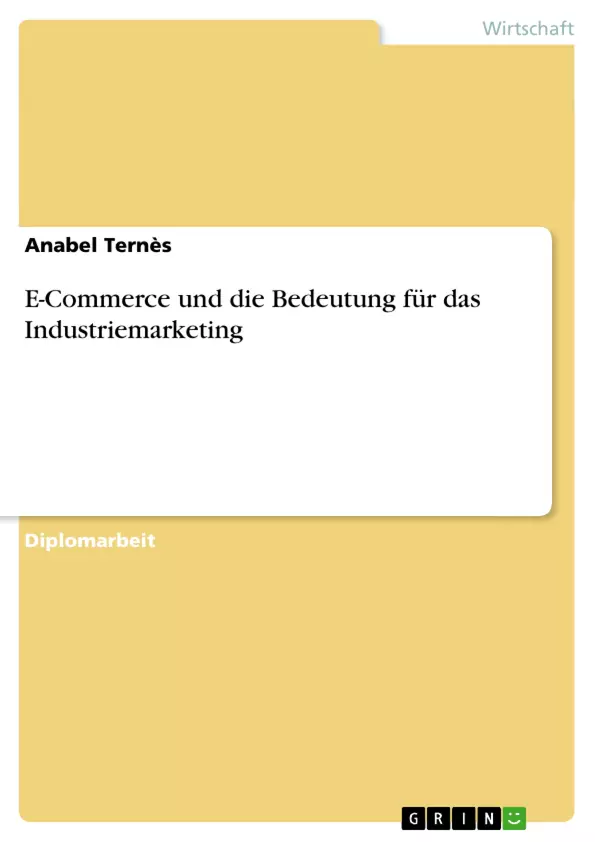„E-Commerce ist resistent gegen Rezessionen. Selbst wenn das Wirtschaftswachstum global betroffen ist, werden die Umsätze aus E-Commerce sich als robust erweisen.“
Jeffrey Lindsay
Welche Potentiale, Chancen und Risiken hat der Einsatz von E – Commerce im Industriegütergeschäft? Die vorliegende Arbeit untersucht dazu den Einsatz von E – Commerce innerhalb der einzelnen Phasen des Industriegütergeschäfts; die Auswirkungen dieses Einsatzes auf die phasenübergreifenden Besonderheiten des Industriegütergeschäfts; und die Änderungen und Herausforderungen an Unternehmen des B2B-Geschäfts durch E - Commerce.
Von der Basis der technischen und begrifflichen Grundlagen des E – Commerce aus steht das Industriegütermarketing im Zentrum der Arbeit. Dabei geht es auch um die Potentiale des E – Commerce für die Marktforschung und für die Wertschöpfung von B2B – Unternehmen aus der Sicht des Marketings. Rechtliche und kostenbezogene Aspekte runden die Darstellung ab.
Inhaltsverzeichnis
- 0. EINLEITUNG
- 0.1. Einführung
- 0.2. Problemstellung
- 0.3. Vorgehensweise
- 1. ELECTRONIC COMMERCE
- 1.1. Begriffsabgrenzung und Definition
- 1.2. Charakteristik des E-Commerce
- 1.2.1. Multimodalität
- 1.2.2. Interaktivität
- 1.2.3. Digitalität
- 1.3. Technische Grundlagen
- 1.3.1. Systemarchitektur
- 1.3.2. Datenbankanbindung
- 1.3.2.1. Direkte Datenbankanbindung
- 1.3.2.2. Anbindung über Zwischenstufen
- 1.3.2.3. Integration von ERP-Systemen
- 1.3.3. HTTP-Server
- 1.3.4. HTTP-Client
- 1.3.4.1. JavaSkript
- 1.3.4.2. ActiveX
- 1.3.4.3. Helper Applications und Plug-ins
- 1.3.5. Sicherheit
- 1.3.5.1. Paßwortgeschützter Zugang
- 1.3.5.2. Verschlüsselungsverfahren
- 1.3.5.3. Message Authentication Code (MAC)
- 1.3.5.4. Integrierte Lösungen
- 1.3.5.5. Trust-Center und digitale Signaturen
- 1.3.6. Online Bezahlungsverfahren
- 1.3.7. EDI
- 1.3.7.1. Internet als Transportmedium
- 1.3.7.2. WebEDI
- 1.3.7.3. EDI und XML
- 1.3.7.4. EDI und SAP R/3
- 1.3.7.5. Zahlung im B2B-Bereich per EDI
- 1.3.7.6. OBI, EDIINT und OpenEDI
- 1.3.8. Betrachtung des Gesamtsystems
- 1.3.8.1. Performance
- 1.3.8.2. Erweiterbarkeit
- 1.3.8.3. Funktionalität
- 1.3.8.4. Mallfähigkeit
- 1.3.8.5. Community-Building
- 1.3.9. Marktübersicht
- 2. INDUSTRIEGÜTERMARKETING
- 2.1. Definition
- 2.2. Klassifizierung der Industriegüter
- 2.3. Charakteristik des Industriegütermarketing
- 2.3.1. Marktobjekte
- 2.3.2. Marktsubjekte
- 2.3.3. Marktprozesse
- 2.4. Das Marketingmix
- 2.4.1. Produktpolitik
- 2.4.2. Kommunikationspolitik
- 2.4.3. Kontrahierungspolitik
- 2.4.5. Distributionspolitik
- 2.5. Phasen und Merkmale der Industriegüterdistribution
- 2.5.1.1. Vorakquisition
- 2.5.1.2. Prozeßunterstützungspotentiale durch EC-Einsatz
- 2.5.1.2.1. Gewährleitung der Auffindbarkeit
- 2.5.1.2.2. Produktpräsentation
- 2.5.1.2.3. Virtuelle Messen
- 2.5.1.2.4. Referenzobjekte
- 2.5.1.2.5. User Groups
- 2.5.1.2.6. Personal Selling
- 2.5.1.2. Prozeßunterstützungspotentiale durch EC-Einsatz
- 2.5.2.1. Akquisition und Angebotserstellung
- 2.5.2.2. Prozeßunterstützungspotentiale durch EC-Einsatz
- 2.5.2.2.1. Database-Marketing
- 2.5.2.2.2. Personalisierung
- 2.5.2.2.3. Produktkonfiguration
- 2.5.2.2.4. Preisfindung
- 2.5.2.2.5. Mass Customization
- 2.5.2.2. Prozeßunterstützungspotentiale durch EC-Einsatz
- 2.5.3.1. Verhandlungsphase
- 2.5.3.2. Prozeẞunterstützungspotentiale durch EC-Einsatz
- 2.5.4.1. Auftragsabwicklung
- 2.5.4.2. Prozeẞunterstützungspotentiale durch EC-Einsatz
- 2.5.4.2.1. Vertragsabschluß
- 2.5.4.2.2. Auftragserfassung
- 2.5.4.2.3. Auftragsumsetzung
- 2.5.4.2.4. Auftragsverfolgung
- 2.5.4.2.5. EDI
- 2.5.4.2.6. Virtuelle Unternehmen
- 2.5.4.2. Prozeẞunterstützungspotentiale durch EC-Einsatz
- 2.5.5.1. Servicephase
- 2.5.5.2. Prozeßunterstützungspotentiale durch EC-Einsatz
- 2.5.5.2.1. Bereitstellung von Informationen
- 2.5.5.2.2. Trouble Shooting
- 2.5.5.2.3 Wartung und Fehlerdiagnose
- 2.5.5.2.4. Computer Based Training
- 2.5.5.2.5. Beschwerdemanagement
- 2.5.5.2.6. Ersatzteilmanagement
- 2.5.5.2. Prozeßunterstützungspotentiale durch EC-Einsatz
- 2.5.6. Marktforschung im Internet
- 2.5.6.1. Konkurrenzbeobachtung
- 2.5.6.2. Thematische Recherchen
- 2.5.6.3.Marketing-Informationen vom eigenen Server
- 2.5.6.4. Online-Befragungen
- 2.6. Bewertung der Prozeßunterstützung
- 2.6.1. Auswirkungen auf die Wertschöpfung
- 2.6.1.1. Informations-, Waren- und Geldflüsse
- 2.6.1.2. Phasenspezifische Unterstützung
- 2.6.1.3. Durchdringung der Wertschöpfungskette
- 2.6.1.4. Differenzierungspotentiale
- 2.6.2. Auswirkungen auf die Kundenzufriedenheit
- 2.6.1. Auswirkungen auf die Wertschöpfung
- 2.7. Kosten
- 2.8. Rechtliche Aspekte
- 2.5.1.1. Vorakquisition
Zielsetzung und Themenschwerpunkte
Diese Diplomarbeit befasst sich mit der Bedeutung des E-Commerce für das Marketing von Industriegütern. Sie analysiert die Herausforderungen und Chancen, die sich aus der Integration von E-Commerce-Technologien in die Prozesse des Industriegütermarketing ergeben.
- Die Bedeutung von E-Commerce im Kontext des Industriegütermarketing
- Die Analyse der technischen Grundlagen des E-Commerce und deren Anwendung im Industriegüterbereich
- Die Untersuchung der Auswirkungen von E-Commerce auf die einzelnen Phasen der Industriegüterdistribution
- Die Bewertung der Kosten und rechtlichen Aspekte des E-Commerce im Industriegütermarketing
- Die Ermittlung von Differenzierungspotentialen durch den Einsatz von E-Commerce im Industriegütermarketing
Zusammenfassung der Kapitel
Die Diplomarbeit beginnt mit einer Einleitung, in der die Problemstellung und die Vorgehensweise der Arbeit dargestellt werden.
Das erste Kapitel widmet sich dem Electronic Commerce und seiner Bedeutung für das Industriegütermarketing. Es werden die technischen Grundlagen des E-Commerce, wie Systemarchitektur, Datenbankanbindung und Online-Bezahlungsverfahren, detailliert erläutert.
Das zweite Kapitel beleuchtet das Industriegütermarketing und untersucht die Charakteristik des Marktes, die relevanten Marktprozesse und die Gestaltung des Marketingmix. Ein besonderes Augenmerk liegt auf der Analyse der einzelnen Phasen der Industriegüterdistribution, wobei die Prozeßunterstützungspotentiale durch den Einsatz von E-Commerce-Technologien im Fokus stehen.
Schlüsselwörter
E-Commerce, Industriegütermarketing, Technische Grundlagen, Distribution, Wertschöpfung, Kundenzufriedenheit, Differenzierungspotentiale, Kosten, Rechtliche Aspekte.
- Quote paper
- Dr. M.A. Anabel Ternès (Author), 2001, E-Commerce und die Bedeutung für das Industriemarketing, Munich, GRIN Verlag, https://www.grin.com/document/166564



